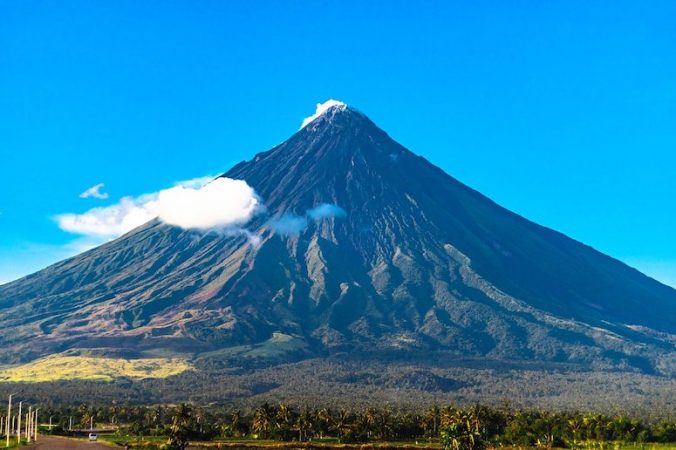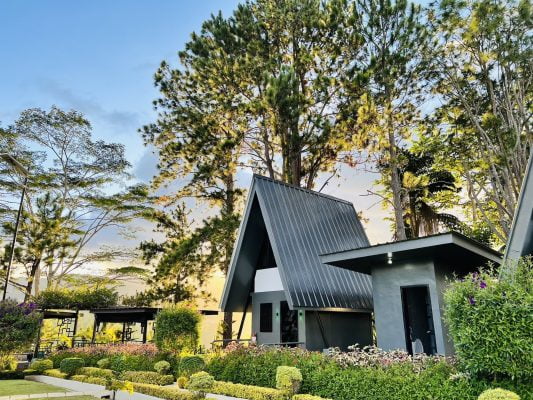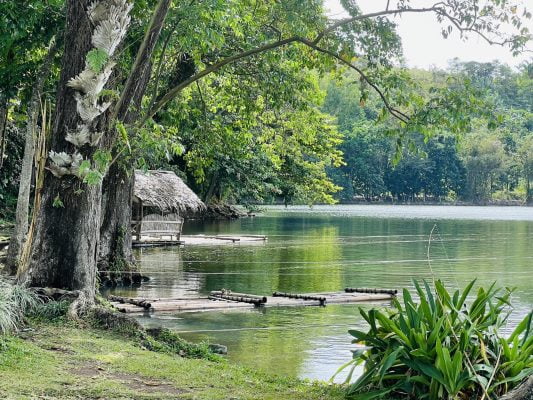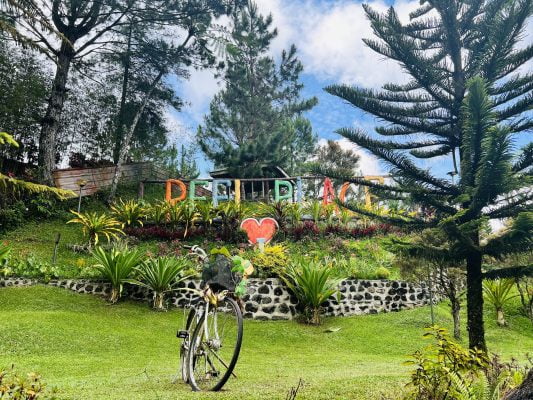The Philippines sits on the Pacific Ring of Fire. This position allows for the formation of volcanoes especially at the junction between the Philippines and Eurasian tectonic plates. As a result, the Philippines is blessed with hundreds of active and dormant volcanoes.
But what are the most active volcanoes in the Philippines? According to the Philippine Institute of Volcanology and Seismology (PHIVOLCS), these are Mts. Mayon, Taal, Kanlaon, Bulusan, and Ragang. There are 20 active volcanoes in the Philippines, mostly located on Luzon island.

While the idea of a volcanic eruption seems daunting and scary, it is actually one of the best spectacles in nature. That is not to say it is not dangerous. As a matter of fact, there have been very destructive eruptions of volcanoes in the Philippines.
Here are the Philippines’ most active volcanoes:
Mt. Mayon
Considered to be one of the most beautiful volcanoes in the world because of its almost perfect conical shape, Mt. Mayon is also the most active volcano in the Philippines. It is located in the province of Albay in the Bicol region.
Mayon has erupted at least 47 times in the last 500 years, the one in 1814 being the most destructive. The eruption buried the town of Cagsawa, leaving over a thousand people dead. The church tower in most photos of Mt. Mayon is a reminder of the catastrophic event.

PHIVOLCS permanently monitors Mt. Mayon. Activities have been observed over the years, including a surprise eruption in 2013. This event killed 5 climbers and left 7 others injured. In 2018, the entire Albay province was placed under a state of calamity as ash, lava, and steam spewed from Mayon’s crater. In early 2020, a magma glow was observed on the volcano’s crater.
Despite and because of its activities, Mt. Mayon remains one of the most popular attractions in the Philippines.
Things to Do
- Explore the forests, rivers, rice fields, and thousands of volcanic rocks along these exciting trails on an ATV with Mt. Mayon providing the perfect backdrop. Book your adventure here.
- Walk back in time and explore the historic remains of Daraga, the town ruined by the catastrophic eruption of Mayon in 1814. Book this one-of-a-kind experience and take postcard-worthy pictures!
- Taste Bicol’s fiery cuisine! Take a culinary tour and experience the region’s one-of-a-kind dishes like laing and bicol express against the backdrop of its equally fiery icon.
Taal Volcano
Known as a volcano island inside a lake in a bigger volcano, Taal is definitely the most interesting volcano in the Philippines. It is also the deadliest. It is located in Batangas, just hours from Manila. Taal is a breathtaking attraction viewed from Tagaytay. Trekking along the volcano was also a popular activity.
Taal has erupted at least 34 times; its latest major eruption was in early 2022. The recent eruptions were destructive, affecting the entire region, Metro Manila, parts of Central Luzon, and even as far as Pangasinan in Ilocos. The towns have since recovered from the effects of the eruptions but a number of people lost their lives because they refused to evacuate.
The eruptions expelled most of the water out of the main crater’s lake but quickly reformed when the rainy season began. Taal volcano remains to be a beautiful natural attraction with plenty of hotels, cafes, and restaurants surrounding it.

Things to Do
- Have a fun day with the entire family at Sky Ranch Tagaytay and see panoramic views of the Taal landscape aboard the iconic Sky Eye. Book your ride-all-you-can pass here.
- Relax and shake off the stresses of city living at the Qiwellness Living Spa with amazing views overlooking Taal Lake. Choose between Silk, Deep Tissue, and Lymphatic Drainage massages and go home renewed and ready to take on the world.
- Immerse the entire family in farm life at Paradizoo, a 10-hectare park with gardens and petting zoos. The kids can roam free and interact with their favorite farm animals while you appreciate the flowers and other plans cultivated in the area
Mt. Kanlaon
The third most active volcano in the Philippines is Mt. Kanlaon in Negros Oriental. It has erupted at least 30 times but most of them have only been mild. It only spewed lava during its eruption in 1904.
There have been activities recorded for Mt. Kanlaon in recent years including volcanic earthquakes and mild eruptions involving ash columns and loud booming sounds. None of these eruptions were destructive.
Mt. Kanlaon is the highest point in the Visayas with an elevation of about 8000 feet above sea level. It is an extremely popular destination for mountain climbers and relaxation seekers. Hot springs around the volcano like Mambucal, Bucalan, and Bungol are just a three-hour scenic drive from Bacolod City.

Things to Do
- Experience a unique mountain adventure at the gateway to Mt. Kanlaon Natural Park: Mambukal Mountain Resort. This is a nature trip like no other with sulfur springs, natural hot springs, and waterfalls.
- Explore the City of Smiles and immerse yourself in local history, culture, and cuisine. Visit popular attractions like Ruins in Bacolod, San Sebastian Cathedral, Laguerta Vintage Glass Museum, and more. Book your tour here.
- Enjoy a day of fun in the sun at Lakawon Island. Dive into the crystal blue waters or kayak around the white sand island and sip on a sunset cocktail at TawHai, the largest floating bar in Asia.
Mt. Bulusan

Mayon’s southern neighbor, Mt. Bulusan, is also an active volcano. It is located in Sorsogon, a coastal province on the southernmost tip of Luzon island.
Although it is the fourth most active volcano in the Philippines with at least 15 recorded eruptions, these have only been mild. Locals are used to ash explosions from the volcano which can last for years. Bulusan’s worst eruption involving lava flows and landslides lasted from 1918 to 1922.
Mt. Bulusan has four craters and several hot springs that draw tourists in. Hiking is also very popular as the trail provides commanding views of the sea and surrounding area. A sea of clouds also envelope the volcano on some days.
Things to Do
- Visit the Philippine Bee Farm, Sorsogon Dairy Farm, and go kayaking in Lake Bulusan on a full-day private tour with a local guide
- Have an enjoyable religious experience through a pilgrimage tour and visit several local churches, see their beautiful structure, and get to know their vast and colorful history
Mt. Ragang
Mt. Ragang is the most active volcano on Mindanao island. It is located in Lanao del Sur in the Autonomous Region of Muslim Mindanao. It is part of a string of volcanoes called the Central Mindanao Arc.
Not much is known of Mt. Ragang. PHIVOLCS recorded at least 8 eruptions, the last being in 1916. Seismologists from the Smithsonian Institution suspect that eruptions of its neighboring volcanoes actually emanated from Mt. Ragang.
Travel to this area in the Philippines is discouraged due to unrest and kidnappings. Having said that, Lanao is a beautiful province with amazing natural attractions like Lake Lanao, Iga-Bai Falls, Kanapnapan Falls, and Mabul Beach. Mt. Ragang’s trails are also home to interesting plant species including the world’s biggest flower.
Other Notable Active Volcanoes in the Philippines
Mt. Hibok-hibok
This young volcano sits on Camiguin Island, a popular tourist destination just off the coast of Cagayan de Oro. Mt. Hibok-hibok is a small volcano with a base diameter of only 10 kilometers. It has 5 recorded eruptions, the most destructive of which happened between 1948 and 1953.
Camiguin is a great destination for all types of travelers. Its popular sand bar is the perfect place for working on your tan. Having four volcanoes also means the island has plenty of hot springs to relax in. Camiguin also has plenty of historic sites protected by UNESCO, including a sunken cemetery which is an interesting dive spot. Fan of tropical fruits? Camiguin produces the sweetest lanzones in the country.

Mt. Pinatubo
Mt. Pinatubo is perhaps the most famous volcano in the Philippines. Its 1991 eruption was so destructive that it displaced tens of thousands of Filipinos and affected the entire island of Luzon. The ash fell as far as the Indian Ocean after the eruption.
Pinatubo’s destruction is a testament to nature’s healing and its resulting beauty. Years after the eruption, the crater lake became one of the most breathtaking sights in the area. The surrounding lahar-laden plains have become popular with off-roaders and hikers. Nearby coasts became even more beautiful as vegetation came back to life.

It would be an amazing experience to see a volcano erupt. I, for one, would like to witness an eruption especially if it involves lava flow. What a sight that would be! Having said that, I wouldn’t want to be caught in an ashfall.
How about you? Have you experienced a volcanic eruption firsthand? Tell us about your experience in the comments below.






